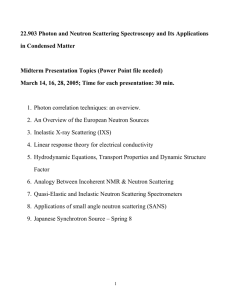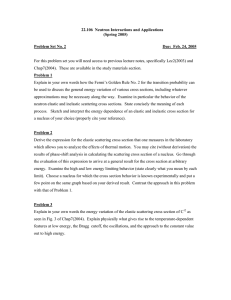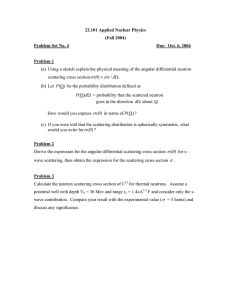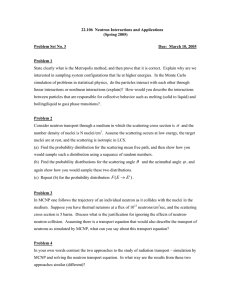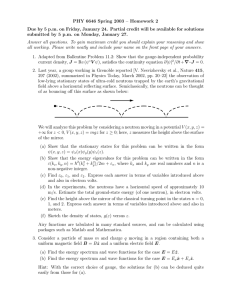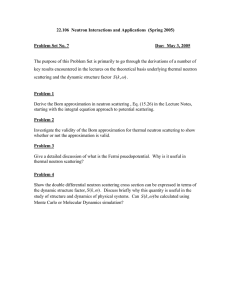Neutron Diffraction Presented by Noël Harris 1
advertisement
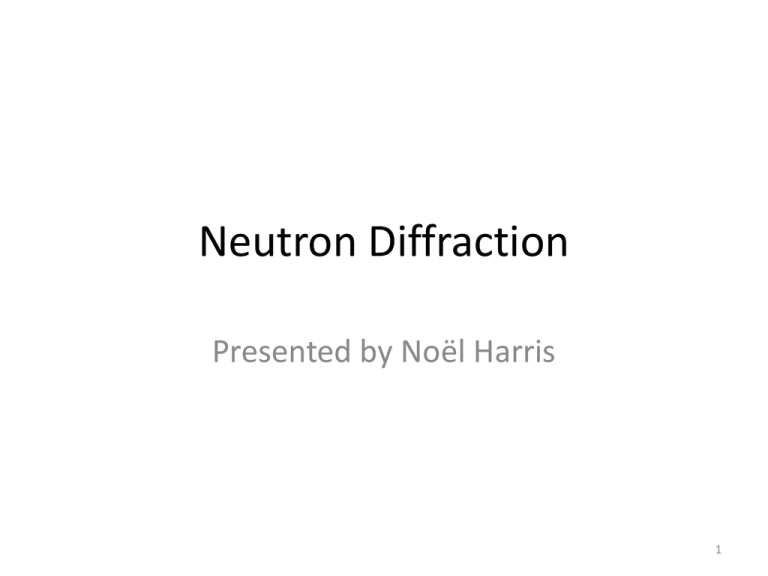
Neutron Diffraction Presented by Noël Harris 1 History • First experiment in 1945 – Ernest O. Wollan • Additional work – Clifford Shull • Nobel prize in physics awarded in 1994 – ½ to Clifford Shull – Wollan died in 1984 2 History • Same method of X-ray diffraction – Discovered in 1895 – First experiment 1912 • Neutron discovered 1932 – 1945, First Reactors to generate free neutrons 3 Neutron Diffraction • Neutron scattering • Free neutrons – Diffraction pattern • Emitted from – Fusion – Fission 4 Neutrons • • • • • Mass = 1.675 x 10–27 kg Charge = 0 Spin = ½ Has a magnetic moment Have wave properties – λ=h/p – Needed for diffraction http://www.ncnr.nist.gov/summerschool/ss09/pdf/Dewey_FP09_Part1.pdf 5 Diffraction • Phenomena when wave encounters a slit • Constructive and destructive interference • Braggs Law – Crystals – 2d sinθn =nλ http://en.wikipedia.org/wiki/Diffraction 6 Why Neutrons • X-rays get distorted with electron cloud – Electrons even worse – Heavy metals • Neutrons have high penetrating power – Due to no charge • Can distinguish isotopes 7 Interactions 8 Penetration depth LANSCE- Neutron scattering primer – Roger Pynn 9 Isotopes • X-rays react predictably with increase in Z – Neutrons do not • H has a largely different signal than D 10 Review • Neutron diffraction – Same method as X-ray diffraction • Better penetration – Direct interaction with the nucleus • Isotope distinguishing 11 General set up 12 Neutron Sources • Reactors – Uranium fission • Spallation – Linear accelerators 13 Reactors • Creates a continuous beam • Must be reduced to a monochromatic beam http://ap.smu.ca/demos/images/stories/Pics/Mousetrap/uranium_fission.gif 14 15 http://www.manep-nccr.ch/img/photo/research-teams/il1swissneutronics2.jpg http://web.ornl.gov/adm/partnerships/success_stories/ge-reuter.shtml 16 Reactor Source: Grenoble, Institute Laue-Langevin http://www.lightsources.org/imagebank/image/esr054 http://hewat.net/science/ill-hewat.html 17 Neutron monochrometers • Pyrolytic graphite • Germanium • Copper http://pd.chem.ucl.ac.uk/pdnn/inst3/monoc.htm 18 Spallation • Linear accelerator – Proton ~ 800 MeV • Hit heavy atoms – Tungsten • About 20 neutrons released http://inspirehep.net/record/776811/files/spall_rys.png 19 Spallation 20 2006 Spallation Neutron Source at Oak Ridge 21 Types of neutrons • • • • • Cold: 0.0-0.025 eV Thermal: 0.025 eV Slow: 1-10 eV Fast: 1-20 MeV Relativistic > 20MeV • Neutrons produced – ~25 MeV Spallation – ~200 MeV Reactor 22 Neutrons moderators • • • • Water- most common Graphite Heavy water Liquid hydrogen http://en.wikipedia.org/wiki/Neutron_moderator 23 1975 NIST Reactor, Gaithersburg, MD http://www.ncnr.nist.gov/NCNRHistory_Rush_Cappelletti.pdf 24 Neutron moderator • Material placed near source • Neutrons lose energy through collisions • Liquid Hydrogen cools to 5 MeV – Neutron wavelength ~ 1.8Å 25 Source: Reactor/Spallation • Large Facilities providing neutrons for 30 to 50 neutron spectrometers – “Small science at large facility” • Locations – – – – – – Europe: 20 North America: 9 Asia: 8 South America: 3 Africa: 1 Australia: 1 http://neutronsources.org/neutron-centres.html 26 Review • Neutrons produced by – Fission – Spallation • Neutrons temperatures • Neutron moderators 27 Nuclear Scattering - Basics • Single fixed nucleus • Neutron behavior is quantum – Particle – Wave • Get same answer 28 Scattering Nomenclature • Cross section – Effective area of nucleus • Point scatter – Ability to diffract in all directions • Isotropic – Wave length of neutron bigger than nucleus 29 Single fixed nucleus 30 Scattering in matter • Nucleus is not fixed • Elastic • Inelastic • (h/2π) Q – Momentum transfer 31 Elastic • Same energy going in as going out • “easiest” –ɛ=0 32 Inelastic • Either a loss or gain of energy • Moving matter 33 Two types of scattering • Coherent – Interacts with sample as a whole – Different nuclei • And incoherent – Independent nuclei 34 Coherent Scattering • Diffraction – – – – Neutrons going in same direction Definite relative phase Interference patterns Elastic scattering • Scattering – Depends on distance between atoms • Gives information of the material 35 Figure 6 switch 36 Structure determination • • • • i,j two atoms r – their respective potions Debye-Waller factor b = Cross section of nucleus 37 Structure determination • Only certain values give a non zero • Q vectors perpendicular to the plane in multiples of 2π/d • Simplifies into Bragg's law – nλ=2dsinθ • Determines atoms: – Spacing – Density 38 Bragg’s law • When wavelength matches d • Primary scattering 39 Elastic scattering • Bucky ball • a.) 3.25 Å • b.)5.5 Å • c.)3.55 Å http://journals.aps.org/prl/pdf/10.1103/PhysRevLett.67.3808 40 Incoherent scattering • Random distribution of nuclear spins – Isotopes – Natural products • Two thirds will have moments flipped • Polarization analysis 41 Representative spectra http://pubs.rsc.org/services/images/RSCpubs.ePlatform.Service.FreeContent.ImageService.svc/ImageService/Articleimage 42 /2015/CP/c4cp04112g/c4cp04112g-f1_hi-res.gif Inelastic spectrum • Globular protein • Measured at different temperatures • Decrease temperature – Inelastic peak visible • Increase temperature – Broader elastic peak http://journals.aps.org/prl/pdf/10.1103/PhysRevLett.65.1080 43 Intensity • Intensity of scattered neutrons is proportional to the square of the density of the atoms • Neutron Fluxes smaller than X-rays • Therefore signal limiting 44 Problems • Real life – More than one atom type – Varying crystal structure – Placing crystal • Computers – unit cells • Sample prep • Analysis technique 45 Review • Inelastic/Elastic Scattering – Coherent – Incoherent • Coherent simplifies to Braggs law – When wavelength = d – 2d sinθn =nλ • Incoherent – Polarized neutrons 46 Techniques • No standard technique • Elastic scattering – Powder diffraction – Small angle • Inelastic scattering – Three axis – Magnetic 47 Powder diffraction • Avoid sample placement issue • Sample is powder • Small samples 48 49 Reactor source 50 http://journals.aps.org/prb/pdf/10.1103/PhysRevB.54.15149 51 52 Spallation source 53 Difference? • Pulse vs continuum source – Get same answer • Independent variable is different 54 Small Angle Scattering • Coherent scattering – Ideal for proteins • Wavelength is larger • Diffraction angle is less than 1 degree • Contrast matching 55 Contrast matching • Mix matrix with sample • Only certain parts are “visible” • Diffraction is usually matched with water with varying amounts of deuterium 56 Contrast matching • Example: an Egg • Yolk is “invisible” • White is “invisible” • Segmenting aids in analysis 57 Small Angle Spectra • Varying matrix composition http://www.sfu.ca/physics/research/workarea/frisken/Research_Files/Macromolecules2006Diblocks.pdf 58 Review • Elastic coherent scattering techniques • Rely on Braggs law • Many techniques – Independent axis changes 59 Moving matter • One moves the others are affected • Chorus line where dancers have to look to their neighbor to see how they move. • Effective waves through out the compound 60 Phonons • This movement gives rise to inelastic coherent scattering • Neutrons frequency = molecular • Appreciable fractionation 61 Three axis spectroscopy • Monochromator • Sample • Analyzer • Measures at constant Q 62 http://nmi3.eu/index.php?rex_img_type=content_noresize&rex_img_file=three-axis_spectroscopy.jpg 63 Inefficient • Each measurement takes several minutes – Scan each wavelength • Complete scan takes several hours to days • Time allows for making adjustment on the fly • In the works is to make a simultaneous measurement. 64 Three axis spectra http://journals.aps.org/prb/pdf/10.1103/PhysRevB.6.4332 65 Incoherent scattering • Usually unwanted back ground • Nucleus at different locations • Isotopes • Magnetic material 66 Magnetic Scattering • Neutron has magnetic moment • Interact with electrons – Unpaired • Ferromagnetic • Antiferromagnetic 67 Ferromagnetic interactions • Ferromagnetic- all electrons in same direction • Non-isotropic interaction • Dipole interaction • Sensitive to magnetic field 68 Antiferromagnetic • Spins are in random up and down positions • Distance is twice as long • Bragg λ is half • Can easily distinguish between regular splitting 69 Flat- Coil Neutron Flipper 70 Using polarized Neutrons 71 Magnetic scattering 72 Magnetic Scattering spectra • Spin density http://pubs.acs.org/doi/pdf/10.1021/ja00084a048 73 74 Other Types of Neutron Spectrometry • • • • • • • Magnetic Reflectometer Liquid Reflectometer Neutron spin echo Backscattering Spectrometer Ultra High Pressure Diffractometer Disordered Materials Diffractometer Chopper Apps: – High Resolution Fermi Spectrometer – Wide-Angle Fermi Spectrometer – Microvolt Muli-Chopper Spectrometer 75 Questions? 76
